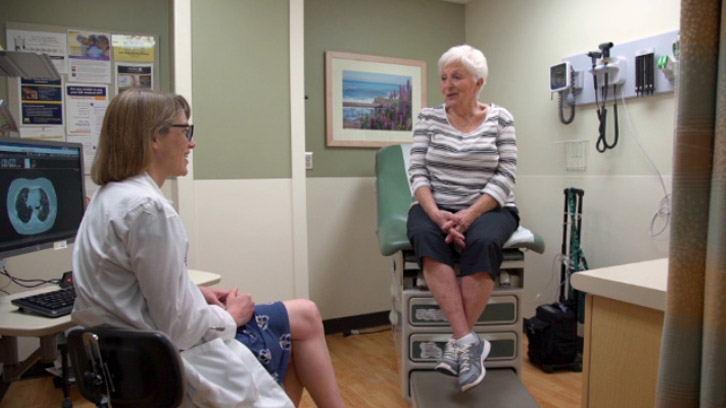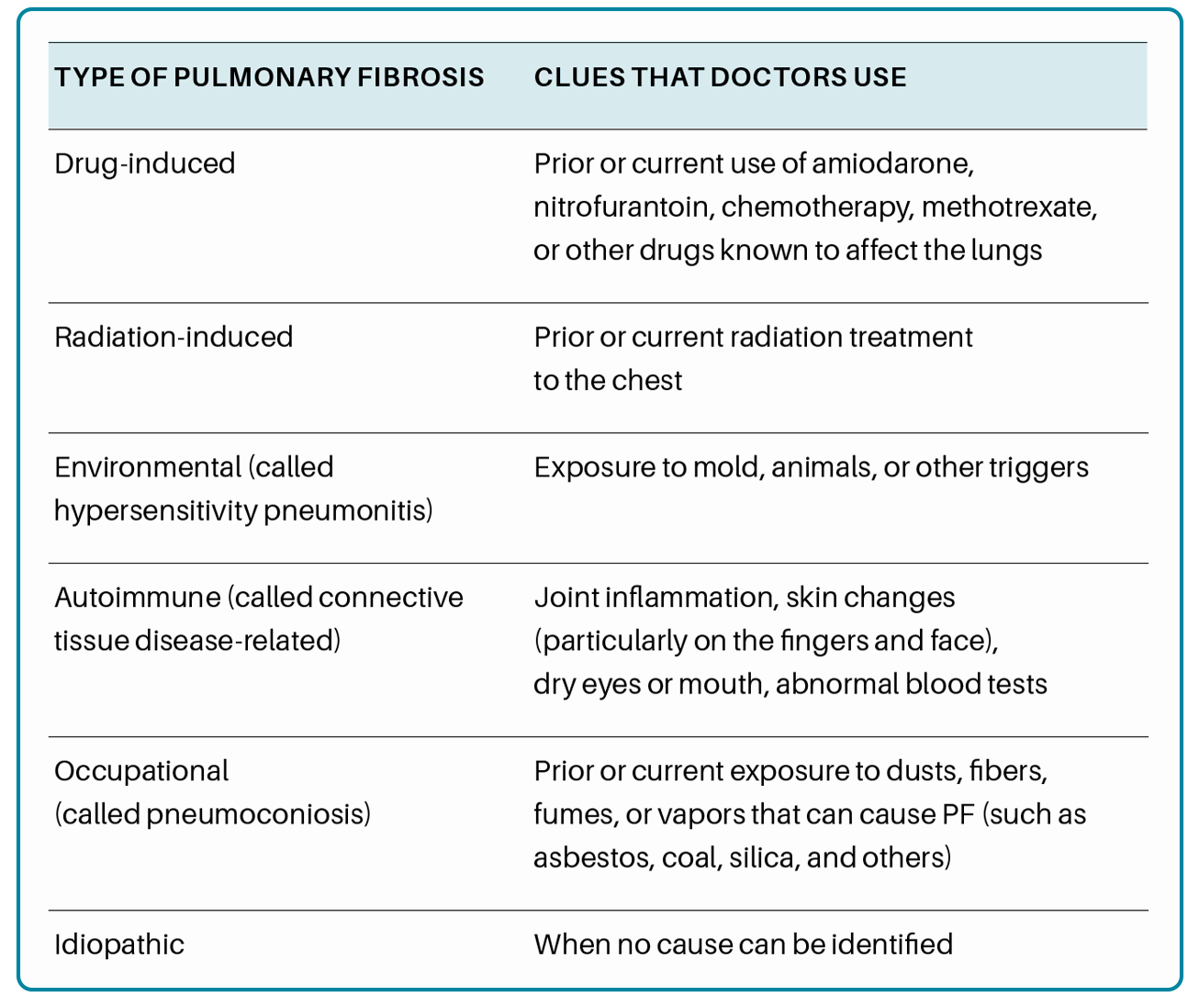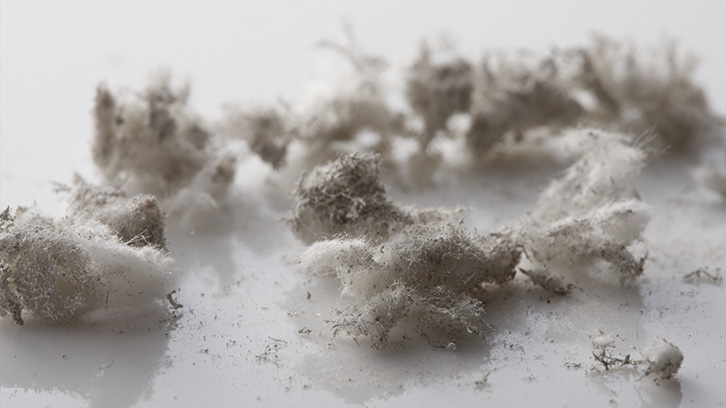Causes

What Causes Pulmonary Fibrosis?
It can be challenging for doctors to figure out what causes PF. Sometimes they are able to identify one or more causes of your disease, which can be found during the diagnostic process. When the cause of the PF is unknown, it is called “idiopathic.” Having a correct diagnosis can be important, because treatment options may vary depending on the type of PF. The Pulmonary Fibrosis Foundation provides details on the latest treatment options and drug development breakthroughs to help improve the quality of life for people living with PF.
Types of Pulmonary Fibrosis
There are five main categories of pulmonary fibrosis that have
identifiable causes. They are: Drug-induced, Radiation-induced,
Environmental, Autoimmune, and Occupational. In the United States,
Environmental and Autoimmune causes seem to be the most common types of
PF of known cause. The table shown here includes some of the clues that
doctors use to identify these known causes of PF. The types of
pulmonary fibrosis that have a known cause are described in the chart.


Medications and Radiation
Some medications can cause PF. Drugs used to treat cancer (chemotherapy), drugs used to treat abnormal heart rhythms (such as amiodarone), drugs used to treat inflammatory conditions (such as methotrexate), and an antibiotic used to treat urinary tract infections (nitrofurantoin) are some of the better known drugs that can cause injury, inflammation, and scarring in the lungs. Numerous other drugs have been implicated as causes of PF in some cases.
Radiation to the chest for lymphoma; Hodgkin’s disease; or breast, lung, and other cancers; can also injure the lung and cause fibrosis.
Environmental and Occupational
Inhaled environmental substances can cause a form of PF called hypersensitivity pneumonitis (HP) or chronic hypersensitivity pneumonitis. HP occurs when the lungs react with inflammation and scarring after breathing in substances such as mold spores, bacteria, animal proteins (especially from indoor or caged birds), or other known triggers. No one is certain why some people are susceptible to developing HP and others are not.
Substances found in occupational settings can cause a form of PF called pneumoconiosis. Exposure to inorganic dusts including asbestos, silica, coal dust, beryllium, and hard metal dusts can cause lung injury when they are inhaled on a regular basis, and for a significant period of time.


Autoimmune Diseases
Autoimmune diseases are also called connective tissue diseases, collagen vascular diseases, or rheumatologic diseases. “Auto” means self and “immune” refers to the immune system. If you have an autoimmune disease that affects your lungs, it means that your body’s immune system is attacking your lungs. Examples of autoimmune diseases that can cause PF include:
- Rheumatoid arthritis;
- Scleroderma (also called systemic sclerosis);
- Sjögren’s syndrome; and
- Polymyositis, dermatomyositis, and antisynthetase syndrome.
What is Idiopathic Pulmonary Fibrosis?
Idiopathic pulmonary fibrosis (IPF) is scarring of the lung where the cause is not known. To make a diagnosis, your doctor will take a thorough history to try to identify potential exposures, causes of injury, or other diseases that might have led to scarring of the lung. If a cause is found, then your diagnosis would not be IPF. The doctor will use detailed X-rays called high-resolution computed tomography (HRCT) and sometimes a lung biopsy to look at the scarring. IPF typically has a distinctive scarring pattern called usual interstitial pneumonia (UIP). A diagnosis of IPF requires that a doctor cannot find a cause for your lung scarring, and that the UIP scarring pattern is seen on your HRCT or surgical lung biopsy sample.
Although IPF is considered to be a disease of unknown cause, we do know some factors that increase the risk of getting IPF, including aging (IPF is rare before age 50), cigarette smoking, and having certain genetic predispositions.


PF and Genetics
What researchers are doing to help
The Pulmonary Fibrosis Foundation is leading the fight by funding promising research and we need your help.
One of our key research programs is the PFF Community Registry. We invite eligible participants to join by completing a series of simple surveys. Your survey responses will be used by researchers to better understand how PF and ILD progress over time, respond to treatments, and how the diseases affect individuals. The more individuals who join and provide responses, the closer we come to a cure.
Eligible participants include:
- Patients living with PF and ILD
- Lung transplant recipients who have had PF or ILD
- Caregivers and biological family members of patients with PF or ILD, including those who have passed away
Enrolling in the PFF Community Registry is entirely online. All you need is internet access. Learn more about this groundbreaking program by visiting the PFF Community Registry homepage.

Educational Materials
Find reliable information and trusted resources that can help you learn about pulmonary fibrosis and live better with PF.
-
View Full Details
Pulmonary Fibrosis Quick Facts
This one-page document provides quick facts about pulmonary fibrosis, including symptoms, causes, treatment options, and more. -
View Full Details
Pulmonary Fibrosis Information Guide
Our comprehensive guide provides reliable information about pulmonary fibrosis, the diagnostic process, treatment options, and more.
PFF Help Center
For those living with pulmonary fibrosis, obtaining the most accurate and current information can be a frustrating and challenging task. Let us help you find your answers.

